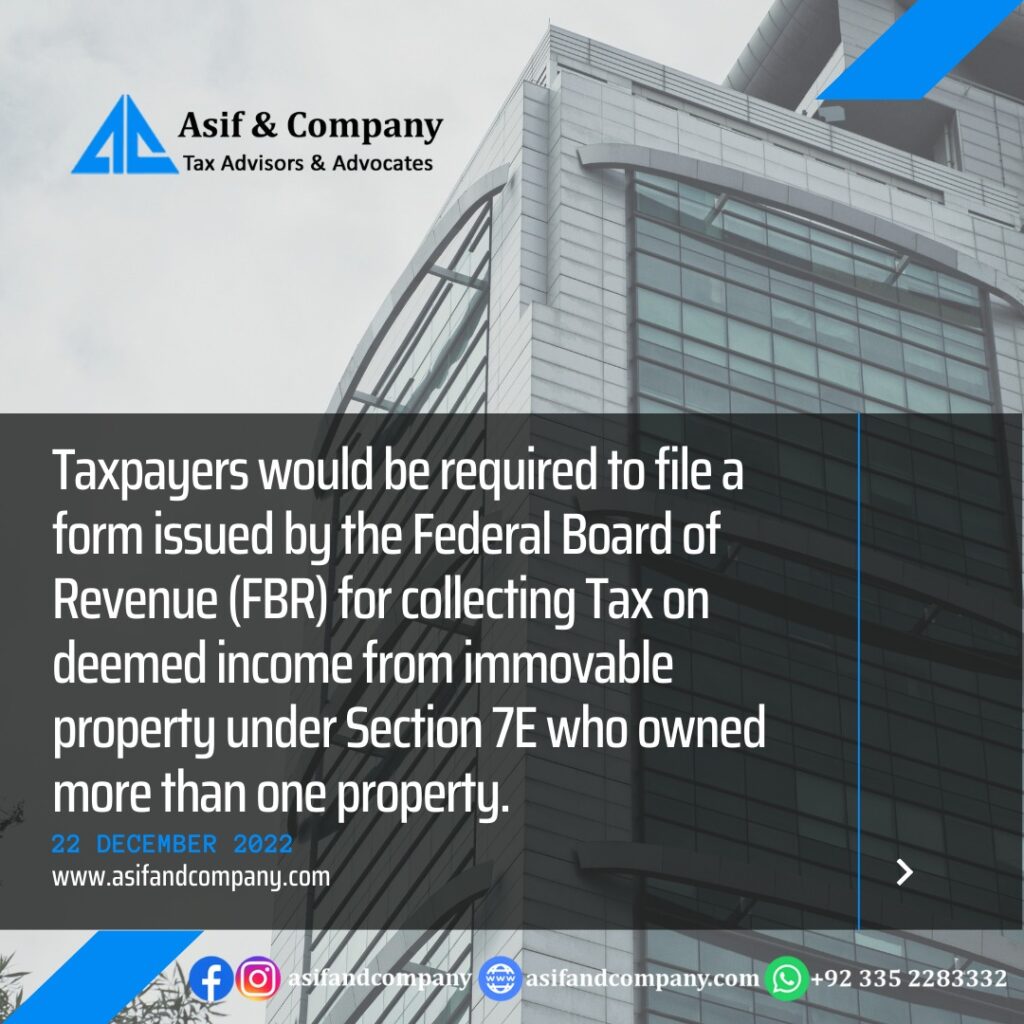Taxpayers Would Be Required To File A Form Issued By The Federal Board Of Revenue (FBR) For Collecting Tax On Deemed Income From Immovable Property Under Section 7E Who Owned More Than One Property.
Through Finance Act, 2022 deemed income on immovable property has been imposed from tax year 2022 (July 01, 2021 – June 30, 2022) and declaration has been made mandatory of the deemed income along with annual return.
The government has introduced a measure under which a resident owning immovable property in Pakistan will be taxed on deemed income for tax year 2022 and onwards. Such deemed income shall be computed as 5% of the fair market value of the immovable property. The rate of tax on such income is prescribed as 20% under Division VIIIC of Part I of First Schedule of the Ordinance.
The FBR introduced the deemed tax form in October for determination and collection of this tax. Now, the authorities have made the filing of the form mandatory for the filers. Even those who had already filed their returns, are required to file the deemed tax form by 31st December 2022. Although many taxpayers approached the higher courts challenging the imposition of the deemed income. But the Sindh High Court (SHC) through its order late October 2022 rejected the petitions and allowed the FBR to levy and collect the tax.
In the new deemed form, the taxpayers are required to provide details of all types of immovable property, including agricultural, industrial, residential and commercial etc., the total value of deemed taxable assets and the deemed income under Section 7E of the Income Tax Ordinance.
FBR officials have said that tax has been imposed on deemed income and the FBR has made filing of the form mandatory from the current tax year i.e. 2022, adding that the last date for filing the deemed tax form is December 31.
The officials said that the tax would be charged at the prevailing rate on the taxable deemed income in view of the particulars to be furnished by the taxpayer. The main objective of this initiative was to increase tax revenue help the FBR achieve the tax collection target.
Following exclusions have been provided to which this section will not apply which are mentioned in Section 7E of Income Tax Ordinance, 2001.
1. For tax year 2022 and onwards, a tax shall be imposed at the rates specified in Division VIIIC of Part-I of the First Schedule on the income specified in this section.
2. A resident person shall be treated to have derived, as income chargeable to tax under this section, an amount equal to five percent of the fair market value of capital assets situated in Pakistan held on the last day of tax year excluding the following, namely:–
a. one capital asset owned by the resident person;
b. self-owned business premises from where the business is carried out by the persons appearing on the active taxpayers’ list at any time during the year;
c. self-owned agriculture land where agriculture activity is carried out by person excluding farmhouse and land annexed thereto;
d. capital asset allotted to:
i. a Shaheed or dependents of a shaheed belonging to Pakistan Armed Forces;
ii. a person or dependents of the person who dies while in the service of Pakistan armed forces or Federal or provincial government;
iii. a war wounded person while in service of Pakistan armed forces or Federal or provincial government; and
iv. an ex-serviceman and serving personal of armed forces or ex-employees or serving personnel of Federal and provincial governments, being original allottees of the capital asset duly certified by the allotment authority;
e. any property from which income is chargeable to tax under the Ordinance and tax leviable is paid thereon;
f. capital asset in the first tax year of acquisition where tax under section 236K has been paid;
g. where the fair market value of the capital assets in aggregate excluding the capital assets mentioned in clauses (a), (b), (c), (d), (e) and (f) does not exceed Rupees twenty-five million;
h. capital assets owned by a provincial government or a local government; or
i. capital assets owned by a local authority, a development authority, builders and developers for land development and construction, subject to the condition that such persons are registered with Directorate General of Designated Non-Financial Businesses and Professions.
3. The Federal Government may include or exclude any person or property for the purpose of this section.
4. In this section–
a. “capital asset” means property of any kind held by a person, whether or not connected with a business, but does not include
i. any stock-in-trade, consumable stores or raw materials held for the purpose of business;
ii. any shares, stocks or securities;
iii. any property with respect to which the person is entitled to a depreciation deduction under section 22 or amortization deduction under section 24; or
iv. any movable asset not mentioned in clauses (i), (ii) or (iii);
“farmhouse” means a house constructed on a total minimum area of 2000 square yards with a minimum covered area of 5000 square feet used as a single dwelling unit with or without an annex:
Provided that where there are more than one dwelling units in a compound and the average area of the compound is more than 2000 square yards for a dwelling unit, each one of such dwelling units shall be treated as a separate farmhouse.


photoshop crack
adobe photoshop crack
acrobat crack
adobe acrobat crack
premiere pro crack
adobe premiere pro crack
filmora crack
filmora crack 2025
Lightroom crack
adobe Lightroom crack
adobe after effects crack
after effects crack
illustrator crack
adobe illustrator crack
disk drill crack
JetBrains crack
JetBrains PyCharm crack
Wallpaper Engine crack
Wallpaper Engine free 2025
valorant hack 2025
valorant aimbot
valorant cheat
capcut crack
capcut pro crack